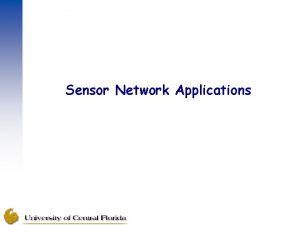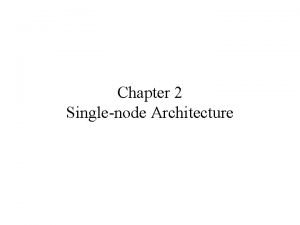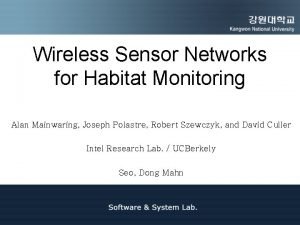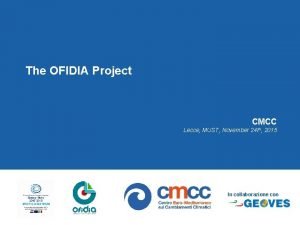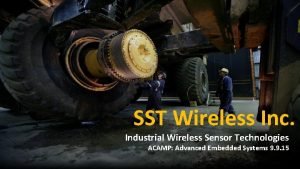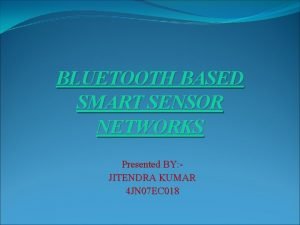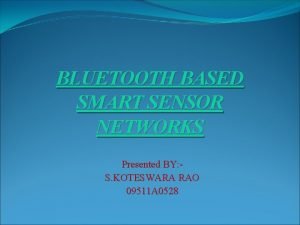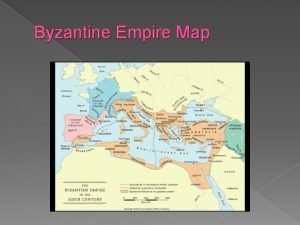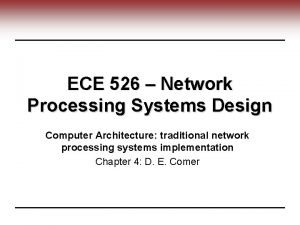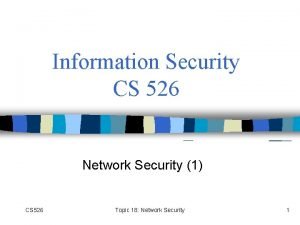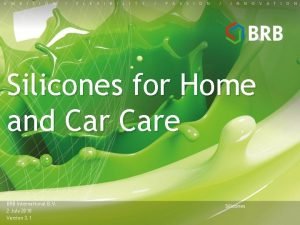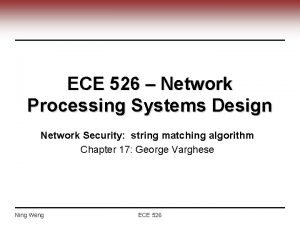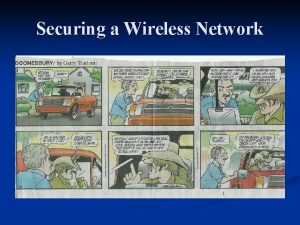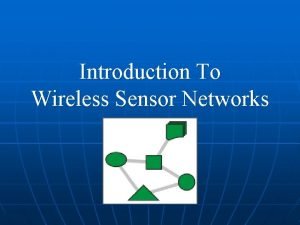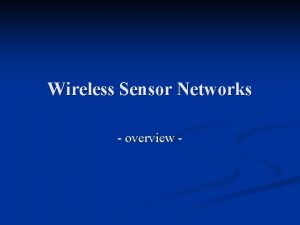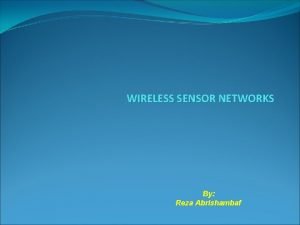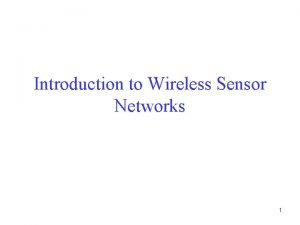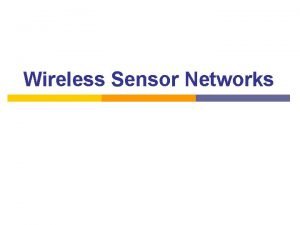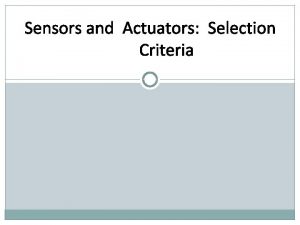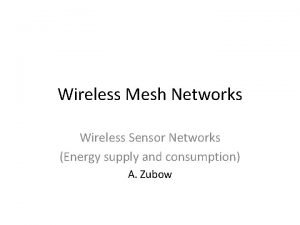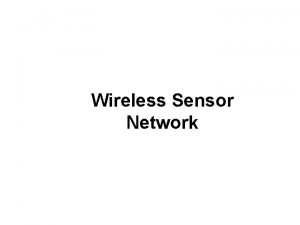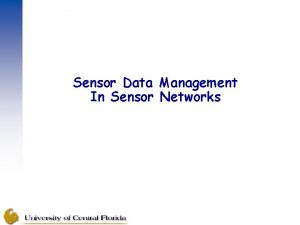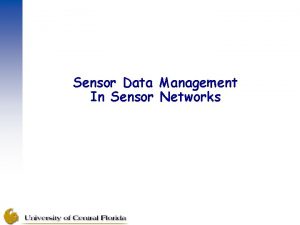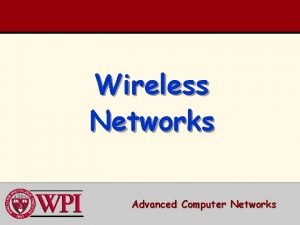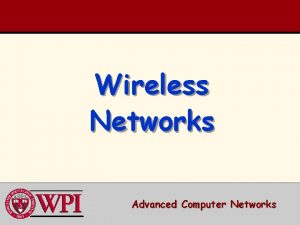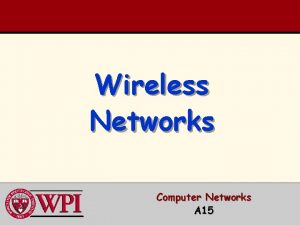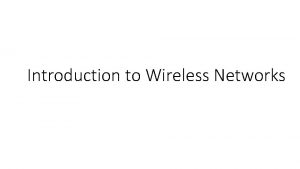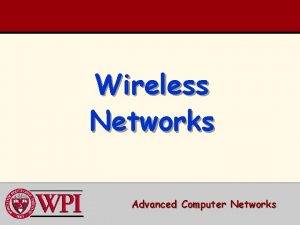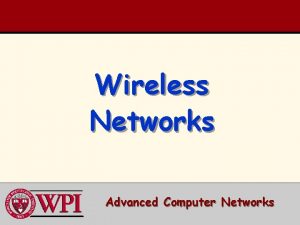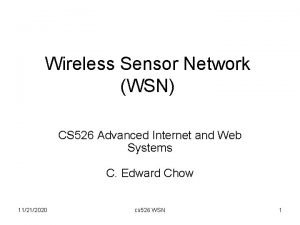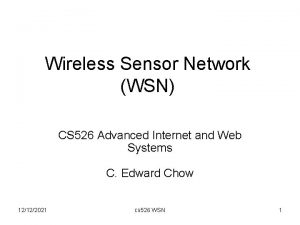CS 526 Wireless Sensor Networks Instructor KD Kang



















- Slides: 19

CS 526 Wireless Sensor Networks Instructor: KD Kang

Smart Dust • Sensor/actuator + processor + wireless interface • Miniature, low cost hardware manufactured in large numbers

Mica 2 Mote Chipcorn CC 1000 38 K or 19 Kbps 315, 433, or 900 MHz 128 KB Instruction EEPROM UART 4 KB Data RAM Atmega 128 L microprocessor 7. 3827 MHz UART, ADC 51 pin expansion connector 512 KB External Flash Memory (16 bytes x 32768 rows)

MTS 420 Sensor Board • • • Light Temperature Humidity Barometric pressure 2 -axis accelerometer GPS

i. Mote 2 • Intel PXA 271 Xscale processor – 13 – 416 MHz • Wireless MMX DSP Coprocessor • 32 MB Flash • 32 MB SDRAM • 802. 15. 4 radio (2. 4 GHz, CC 2420) • Application Specific I/O – I 2 S, AC 97, Camera Chip Interface, JTAG

What are sensor networks? • Small, wireless, battery-powered sensors MICA 2 mote Smart Dust

Why small, wireless, batterypowered sensors? • Traditional big, wired sensors – Expensive, inefficient, hard to deploy, powerconsuming – Undesirable: For example, deployment of big traditional sensors can disturb the environment in habitat monitoring – Dangerous: Imagine manual deployment of big traditional sensors for disaster recovery or battlefield monitoring

WSN Applications • Inexpensive micro-sensors & on-board processing embedded in environments for fine-grained in-situ monitoring • Ad-hoc deployment – No communication infra should be built ahead of time Structural health monitoring Fire monitoring Habitat monitoring

Applications Habitat Monitoring Great Duck Island Medical Application Code. Blue at Harvard Structural Monitoring Golden Gate Bridge Precision Agriculture

Mote. Lab • Harvard WSN testbed open to the public • 190 TMote Sky sensor motes – – TI MSP 430 processor running at 8 MHz 10 KB of RAM 1 Mbit of Flash memory Chipcon CC 2420 radio operating at 2. 4 GHz with an indoor range of approximately 100 meters – Each node includes sensors for light, temperature, and humidity. • http: //motelab. eecs. harvard. edu/

City. Sense - An Open, Urban. Scale Sensor Network Testbed http: //www. citysense. net

Course Topics • • Operating Systems Programming & Debugging Medium access control Routing Localization Query processing and data aggregation Security

Grading • • • Paper critique: 10% Paper presentation: 20% Midterm: 20% (No final exam ) Project: 40% Class Participation: 10%

One Page Paper Critique • Not a complete essay but more of a bulleted list • Part A: Briefly identify the key contributions of the paper – What research problem does it try to solve? – Why is it an important problem? – What's the proposed approach? • Part B: Try to find if there is any problem in the paper – Any problems in the assumptions? – Any technical shortcomings or drawbacks? – Do the experimental results support the original claim? • Part C: Any idea for improvement? (Optional) – Most challenging part – You can get the full credit by finishing Parts A and B – But, you are encouraged to try do this part as well

Paper Presentation • 35 - 40 minute presentation per student – Present key ideas, algorithms/heuristics & performance results – Discuss related work to show the paper presented by you is different from other work – A list of papers for student presentations will be provided • Find more related papers yourself if necessary • 5 minutes for questions & discussions

Project • 2 -3 students can work as a team – Find your team! • Implement an existing protocol in OMNe. T++ or Motelab – OMNe. T++ is easier to use that ns-2 – If you plan to use Motelab, confirm your protocol works properly by implementing and verifying it first in TOSSIM (Tiny. OS Simulator) • Extend the protocol or develop your own approach • Compare their performance

Project • Examples: – Implement an existing MAC, packet scheduling, routing, or data aggregation/in-network data processing protocol and tweak it to improve the performance or reliability – Implement a routing protocol and inject attacks such as packet dropping attacks; Observe what happens & investigate a possible countermeasure – Tell me which topic you choose before you go too far! Use your imagination!

Next Class • Read “Overview of Sensor Networks” in the Reading List (http: //www. cs. binghamton. edu/~kang/teaching/cs 580 s/) – No critique due

Questions?
 Wireless sensor networks for habitat monitoring
Wireless sensor networks for habitat monitoring Single node architecture in wsn
Single node architecture in wsn Alan mainwaring
Alan mainwaring Geoves butterfly wireless multi sensor
Geoves butterfly wireless multi sensor Sensor wireless inc
Sensor wireless inc Wireless sensor network protocols
Wireless sensor network protocols Telosb
Telosb Telecommunications the internet and wireless technology
Telecommunications the internet and wireless technology Bluetooth based smart sensor networks
Bluetooth based smart sensor networks Bluetooth based smart sensor networks
Bluetooth based smart sensor networks Byzantine empire 526 ce
Byzantine empire 526 ce Ece 526
Ece 526 Rounding jeopardy
Rounding jeopardy Ece 526
Ece 526 How was byzantium a continuation of the roman empire?
How was byzantium a continuation of the roman empire? Network security process
Network security process Então meu deus
Então meu deus Silicone logo
Silicone logo Ece 526
Ece 526 Wireless networks
Wireless networks
